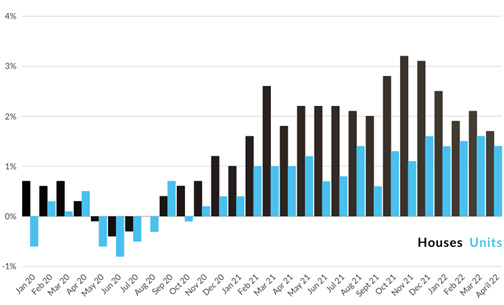Brisbane house, unit markets continue their goal sprees
The juggernaut that is the Brisbane property market continues to kick more goals than the combined efforts of its powerful AFL and NRL teams.
The juggernaut that is the Brisbane property market continues to kick more goals than the combined efforts of its powerful AFL and NRL teams.
Brisbane homeowners on average made more than $20,000 last month and it’s been almost two years since the Brisbane property market took a backward step.
The market again recorded strong price growth in April, according to the CoreLogic Hedonic Home Value Index, with dwelling price growth of 1.7 per cent.
This is at the same time as markets in Sydney and Melbourne head south.
Brisbane continues to power along in almost every measurable index.
Rents are soaring and vacancy rates plunging throughout Queensland, the economy is booming, unemployment falling, inward migration continues unabated, and investor finance commitments are increasing.
Other than rising interest rates, the headwinds holding back the Brisbane property market appear insipid.
The growth across Brisbane was still slightly stronger in the housing sector (1.7 per cent) compared to the unit sector (1.4 per cent) but the gap in month-on-month growth between these two product types appears to be decreasing.
Growth in units vs houses

Source: CoreLogic
Brisbane has now experienced month-on-month price growth since August 2020.
The peak rate of growth in the housing sector was achieved in November 2021 when the depth of buyers across the city was peaking.
The median value for a house in Brisbane is currently at a record high of $880,332, which is $23,601 above a month ago.
In the unit market, the median value reached a new high again this month. The median unit price in Brisbane is now $487 967, which is $8,405 higher than last month.
In the face of floods
Despite the floods in late February, there has been no pull-back in property prices throughout the city.
The 2011 floods were a very different story. Then, the macroeconomic conditions were also very different, and it confirms that property values are driven by a variety of interrelated factors that underpin supply and demand.
It will be interesting to see if demand for Brisbane properties dampens in the near future.
Over the past 12 months, every suburb in Brisbane has experienced positive house price growth. In the unit sector, prices have dropped by less than 1 per cent in some places, but most suburbs have experienced positive price growth.
The historically low interest rate environment, together with many other local factors contributing to low supply and high demand, has generated a boom across the whole city.
The commentary around rising interest rates will cause some fear to permeate the market.
The reality is that not every mortgagee will be affected in the same way. The same is true for property buyers.
Unemployment is at its lowest level since the 1970s, sitting at 3.95 per cent nationwide. Queensland has added close to 100,000 new jobs over the last 12 months according to the ABS data released in March, so the state has recovered extremely well. It is reasonable to assume with unemployment rates so low that upward pressure on wages will emerge. This will also partially offset interest rate rises in the future.
Rentals scarce
Rising rents will also cancel out interest rate increases.
Investor finance commitments have increased in Queensland to 35 per cent of all lending, compared to a national figure sitting at 33.3 per cent. This shows a commitment from individuals and institutions to invest into property in a market where rents are on the rise.
In the last 12 months, Brisbane house rents have increased 12.2 per cent and Brisbane unit rents by 7.2 per cent.
The annual change in Brisbane house rents is the strongest rental market among the state and territory capitals.
Since the floods at the end of February, and also with international borders now open, even the inner-city rental market is tight.
There is very little available to rent, regardless of where tenants are looking throughout the city. It is a tough market for tenants to find a home, a problem that will remain for some time yet.
Over the last month, auction clearance rates have recovered.
During the four weekends in March, according to Domain, Clearance Rates across Brisbane averaged just 57 per cent, but this week was at 69.3 per cent.
Fewer registered bidders are appearing at auctions, a sign that the buyer demand has softened.
Although the demand has softened marginally, there are still more buyers than sellers, which is why prices are still on the rise. There is no evidence of prices easing.
Brisbane should remain a fairly resilient market in many areas amid higher interest rates due to its relative affordability, low levels of supply and the continuing strong interstate migration flows.
A higher volume of people relocating is supporting the demand for residential property and this is not a trend that rising interest rates are likely to dampen.
Total listings remain 21 per cent lower than 12 months ago in Brisbane and more than 40 per cent below the five-year average, according to CoreLogic.
Unless there is a huge increase in the number of properties available for sale, the market will likely continue kicking goals for the rest of the football season at least.



















